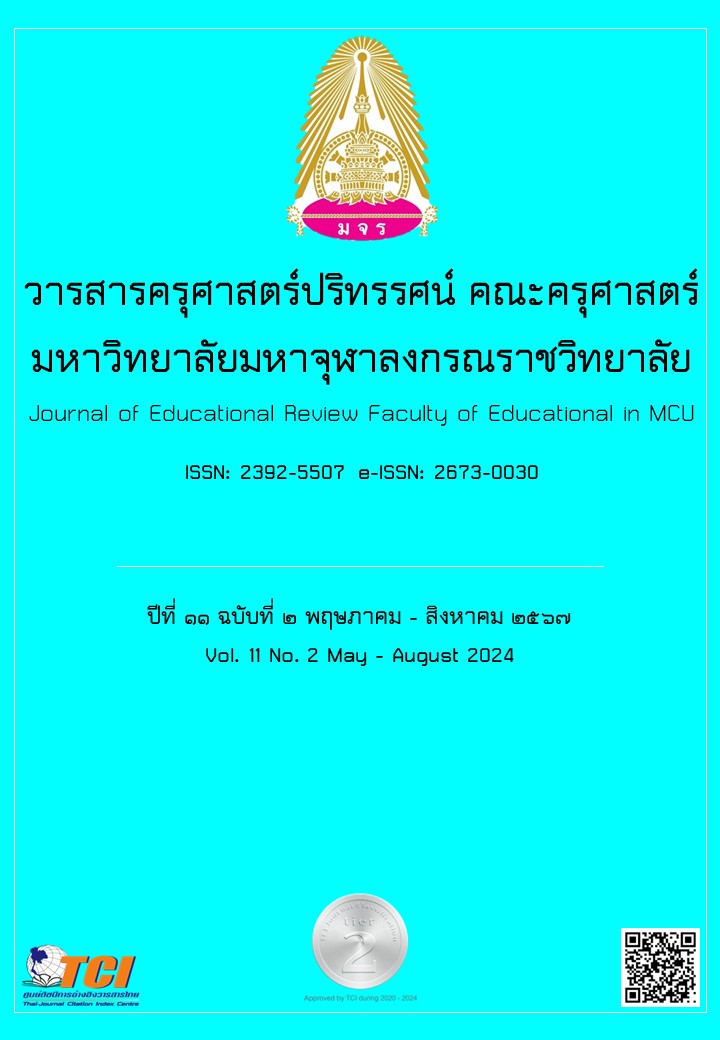สภาพปัจจุบันและสภาพที่พึงประสงค์การบริหารสถานศึกษาเพื่อเสริมสร้างภาวะผู้นำเชิงสร้างสรรค์แก่นักเรียน โรงเรียนอนุบาลประจำจังหวัด ประเทศไทย (ภาคกลาง)
Main Article Content
บทคัดย่อ
บทความวิจัยนี้มีวัตถุประสงค์เพื่อศึกษาสภาพปัจจุบันและสภาพที่พึงประสงค์การบริหารสถานศึกษาเพื่อเสริมสร้างภาวะผู้นำเชิงสร้างสรรค์แก่นักเรียน โรงเรียนอนุบาลประจำจังหวัด ประเทศไทย (ภาคกลาง) โดยมีวิธีดำเนินการวิจัย 3 ส่วน ประกอบด้วยส่วนที่ 1 ศึกษา วิเคราะห์และสังเคราะห์เอกสาร แนวคิด ทฤษฎีและงานวิจัยที่เกี่ยวข้องกับการบริหารสถานศึกษาและการเสริมสร้างภาวะผู้นำเชิงสร้างสรรค์แก่นักเรียน ส่วนที่ 2 ศึกษาระดับภาวะผู้นำเชิงสร้างสรรค์ของนักเรียน โดยแบบประเมินภาวะผู้นำเชิงสร้างสรรค์ สำหรับนักเรียน เป็นผู้ประเมินตนเอง และแบบประเมินภาวะผู้นำเชิงสร้างสรรค์ของนักเรียน โดยครูเป็นผู้ประเมินนักเรียน ส่วนที่ 3 การศึกษาสภาพปัจจุบันและสภาพที่พึงประสงค์ของการบริหารสถานศึกษาเพื่อเสริมสร้างภาวะผู้นำเชิงสร้างสรรค์แก่นักเรียน โดยมีกลุ่มผู้ให้ข้อมูล ประกอบด้วย 1) ครูผู้รับผิดชอบกิจกรรมสภานักเรียน โรงเรียนละ 1 คน และ 2) นักเรียนที่ดำรงตำแหน่งประธานนักเรียน โรงเรียนละ 1 คน รวมจำนวน 44 คน สรุปผลการวิจัย พบว่า ระดับภาวะผู้นำของนักเรียนโรงเรียนอนุบาลประจำจังหวัด ประเทศไทย (ภาคกลาง) โดยภาพรวม พบว่า คุณลักษณะทุกด้านมีค่าเฉลี่ยในระดับมาก และรูปแบบการบริหารสถานศึกษาเพื่อเสริมสร้างภาวะผู้นำเชิงสร้างสรรค์แก่นักเรียนโรงเรียนอนุบาลประจำจังหวัด ประเทศไทย (ภาคกลาง) จำแนกตามองค์ประกอบของรูปแบบการบริหารโรงเรียน 8 องค์ประกอบ ดังนี้ 1) ระดับของการกำหนดเป้าประสงค์ อันดับที่ 1 คือ รูปแบบทางการและรูปแบบเพื่อนร่วมงาน 2) กระบวนการกำหนดเป้าประสงค์ อันดับที่ 1 คือ รูปแบบเพื่อนร่วมงาน 3) ความสัมพันธ์ระหว่างเป้าประสงค์และการตัดสินใจ อันดับที่ 1 คือ รูปแบบเพื่อนร่วมงาน 4) ลักษณะของกระบวนการตัดสินใจ อันดับที่ 1 คือ รูปแบบทางการ 5) ลักษณะของโครงสร้าง คือ รูปแบบเพื่อนร่วมงาน 6) การเชื่อมโยงกับสภาพแวดล้อมภายนอก อันดับที่ 1 คือ รูปแบบเพื่อนร่วมงาน 7) ลักษณะของภาวะผู้นำ อันดับที่ 1 คือ รูปแบบเพื่อนร่วมงาน 8) รูปแบบภาวะผู้นำที่เกี่ยวข้อง อันดับที่ 1 คือ รูปแบบเพื่อนร่วมงาน
Article Details

This work is licensed under a Creative Commons Attribution-NonCommercial-NoDerivatives 4.0 International License.
ทัศนะและความคิดเห็นที่ปรากฏในบทความในวารสารฉบับนี้ถือเป็นความรับผิดชอบของผู้เขียนบทความนั้นเพียงผู้เดียว และไม่ถือเป็นทัศนะและความรับผิดชอบของกองบรรณาธิการ
กองบรรณาธิการขอสงวนสิทธิ์ในการคัดเลือกบทความลงตีพิมพ์และจะแจ้งให้เจ้าของบทความทราบหลังจากผู้ประเมินบทความตรวจอ่านบทความแล้ว
ต้นฉบับที่ได้รับการตีพิมพ์ในวารสารครุศาสตร์ปริทรรศน์ คณะครุศาสตร์ มหาวิทยาลัยมหาจุฬาลงกรณราชวิทยาลัย ถือเป็นกรรมสิทธิ์ของคณะครุศาสตร์ มหาวิทยาลัยมหาจุฬาลงกรณราชวิทยาลัย ห้ามนำข้อความทั้งหมดหรือบางส่วนไปพิมพ์ซ้ำ เว้นเสียแต่ว่าจะได้รับอนุญาตจากมหาวิทยาลัยฯ เป็นลายลักษณ์อักษร
References
กิตติ์กาญจน์ ปฏิพันธ์. (2555). โมเดลสมการโครงสร้างภาวะผู้นำเชิงสร้างสรรค์ของผู้บริหารสถานศึกษาอาชีวศึกษา. ดุษฎีนิพนธ์ศึกษาศาสตรดุษฎีบัณฑิต. มหาวิทยาลัยขอนแก่น.
เกรียงศักดิ์ เจริญวงศ์ศักดิ์. (2553). การคิดเชิงสร้างสรรค์. กรุงเทพมหานคร: ชัคเซส มีเดีย.
ชาญชัย อาจินสมาจาร. (2543). ทักษะภาวะผู้นำ. กรุงเทพมหานคร: มัลติอินฟอร์เมชั่นเทคโนโลยี.
ชาญชัย อาจินสมาจาร. (2555). หลักการบริหารการศึกษาและการจัดการศึกษา. ปัตตานี: สถาบันเพื่อความก้าวหน้า
ป.มหาขันธ์. (2539). สอนเด็กให้มีความคิดสร้างสรรค์. กรุงเทพมหานคร: โอเดียนสโตร์.
ไพฑูรย์ สินลารัตน์. (2553). ผู้นำเชิงสร้างสรรค์และผลิตภาพ: กระบวนทัศน์ใหม่และผู้นำใหม่ทางการศึกษา. กรุงเทพมหานคร: สำนักพิมพ์จุฬาลงกรณ์มหาวิทยาลัย.
สำนักงานคณะกรรมการการศึกษาขั้นพื้นฐาน. (2553). หลักสูตรแกนกลางการศึกษาขั้นพื้นฐานพุทธศักราช 2551. พิมพ์ครั้งที่ 3. กรุงเทพมหานคร: โรงพิมพ์ชุมชนสหกรณ์การเกษตรแห่งประเทศไทย.
สำนักงานคณะกรรมการการศึกษาขั้นพื้นฐาน. (2554). แนวทางการจัดการเรียนรู้สู่ประชาคมอาเซียนระดับประถมศึกษา. กรุงเทพมหานคร: โรงพิมพ์ชุมชนสหกรณ์การเกษตรแห่งประเทศไทย.
สำนักงานคณะกรรมการการศึกษาแห่งชาติ. (2545). พระราชบัญญัติการศึกษาแห่งชาติ พ.ศ. 2542 และที่แก้ไขเพิ่มเติม (ฉบับที่ 2) พ.ศ. 2545. กรุงเทพมหานคร: พริกหวานกราฟฟิค.
สำนักงานเลขาธิการสภาการศึกษา. (2552). ข้อเสนอการปฏิรูปการศึกษาในทศวรรษที่สอง (พ.ศ.2552-2561). กรุงเทพมหานคร: พริกหวานกราฟฟิค.
สุเทพ พงศ์ศรีวัฒน์. (2545). ภาวะผู้นำ: ทฤษฎีและปฏิบัติ. กรุงเทพมหานคร: บุคส์ลิงค์.
อุดม มุ่งเกษม. (2545). Good Governance กับการพัฒนาข้าราชการ. กรุงเทพมหานคร: สถาบันพัฒนาข้าราชการพลเรือน.
อุษณีย์ โพธิสุข. (2543). สร้างสรรค์นักคิด : คู่มือการจัดการศึกษาสำหรับผู้มีความสามารถพิเศษด้านทักษะความคิดระดับสูง. กรุงเทพมหานคร: รัตนพรชัย.
Bennis. W. (2002). Creative Leadership. Bangkok: Chulalongkorn University.
Dubrin, A.J. (2012). Leadership: Research Findings Practice and Skills. 7th ed. New York: Houghton Mifflin Company.
Jacob, J. P., Mitaru, B. N., Mbugua, P. M. & Blair, R. (1996). The effect of substituting Kenyan Serena sorghum for maize in broiler starter diets with different dietary crude protein and methionine levels. Feed Sci Technol. 61. 27-39.
Keeves, P.J. (2005). Educational Research, Methodology and Measurement:An International Handbooks. Oxford: Pergamon Press.
Keeves, Peter J. (1988). Model and Model Building: Educational Research Methodology and Measurenment : An Intermational Handbook. Oxford: Pergamon Press.
Knight, C.F. (2005). Performance without Compromise. Boston: Harvard Business Press.
Krejcie, R. V. & Morgan, D. W. (1970). Determining sample size for research activities. Educational and Psychological Measurement. 30(3). 607–610.
Puccio, G.J. (2011). Creative Leadership: Skills That Drive Change. 2nd ed. Los Angeles: Sage Publications.
Sternberg, R.J. (2005). A Model of Educational Leadership: Wisdom Intelligence and Creativity Synthesized. Chulalongkorn University.

